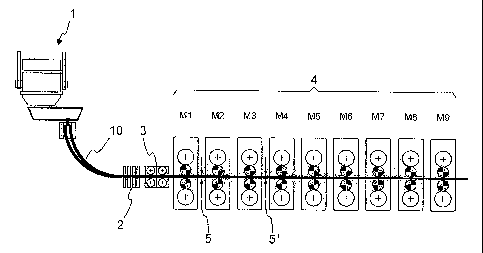Some of the information on this Web page has been provided by external sources. The Government of Canada is not responsible for the accuracy, reliability or currency of the information supplied by external sources. Users wishing to rely upon this information should consult directly with the source of the information. Content provided by external sources is not subject to official languages, privacy and accessibility requirements.
Any discrepancies in the text and image of the Claims and Abstract are due to differing posting times. Text of the Claims and Abstract are posted:
| (12) Patent: | (11) CA 2611396 |
|---|---|
| (54) English Title: | PROCESS AND RELATED PLANT FOR MANUFACTURING STEEL LONG PRODUCTS WITHOUT INTERRUPTION |
| (54) French Title: | PROCESSUS ET INSTALLATION AFFERENTE POUR FABRIQUER DES PRODUITS ALLONGES EN ACIER SANS INTERRUPTION |
| Status: | Deemed Expired |
| (51) International Patent Classification (IPC): |
|
|---|---|
| (72) Inventors : |
|
| (73) Owners : |
|
| (71) Applicants : |
|
| (74) Agent: | GOWLING WLG (CANADA) LLP |
| (74) Associate agent: | |
| (45) Issued: | 2012-06-19 |
| (86) PCT Filing Date: | 2005-07-19 |
| (87) Open to Public Inspection: | 2007-01-25 |
| Examination requested: | 2010-02-18 |
| Availability of licence: | N/A |
| Dedicated to the Public: | N/A |
| (25) Language of filing: | English |
| Patent Cooperation Treaty (PCT): | Yes |
|---|---|
| (86) PCT Filing Number: | PCT/IT2005/000413 |
| (87) International Publication Number: | WO 2007010565 |
| (85) National Entry: | 2007-12-05 |
| (30) Application Priority Data: | None |
|---|
A process for manufacturing steel long products provides for starting from a
continuous casting step (1) with liquid core reduction, followed by induction
heating (2) without interruption until the end of a rolling step (4) in a
plurality of stands. The blooms or billets (10) subjected to such a process
have initial thickness in the range between 120 and 400 mm and a high "mass
flow" passing in the time unit at the outlet from the continuous casting, as
well as an average temperature in the cross-section which is higher than the
surface temperature, being in the core or inner middle region higher by 100~C
than on the surface, that is of about 1200~C. A plant for carrying out such a
process is also described.
La présente invention concerne un processus de fabrication de produits allongés en acier commençant par une étape de coulage continu (1) avec réduction du coeur liquide, suivie par un chauffage par induction (2) sans interruption jusqu'à la fin d'une étape de laminage (4) dans une pluralité de supports. Les blooms ou billettes (10) soumis à ce processus ont une épaisseur initiale de l'ordre de 120 à 400 mm et un débit massique élevé dans le temps à la sortie du coulage en continu, et également une température moyenne dans la section transversale qui est supérieure à la température de surface, dans le coeur ou dans la région médiane interne supérieure de 100 °C à celle de la surface, qui est d'environ 1200 °C. Une installation pour réaliser ce processus est également décrite.
Note: Claims are shown in the official language in which they were submitted.
Note: Descriptions are shown in the official language in which they were submitted.

2024-08-01:As part of the Next Generation Patents (NGP) transition, the Canadian Patents Database (CPD) now contains a more detailed Event History, which replicates the Event Log of our new back-office solution.
Please note that "Inactive:" events refers to events no longer in use in our new back-office solution.
For a clearer understanding of the status of the application/patent presented on this page, the site Disclaimer , as well as the definitions for Patent , Event History , Maintenance Fee and Payment History should be consulted.
| Description | Date |
|---|---|
| Letter Sent | 2024-01-19 |
| Letter Sent | 2023-07-19 |
| Common Representative Appointed | 2019-10-30 |
| Common Representative Appointed | 2019-10-30 |
| Change of Address or Method of Correspondence Request Received | 2018-01-10 |
| Grant by Issuance | 2012-06-19 |
| Inactive: Cover page published | 2012-06-18 |
| Pre-grant | 2012-04-02 |
| Inactive: Final fee received | 2012-04-02 |
| Notice of Allowance is Issued | 2011-12-23 |
| Letter Sent | 2011-12-23 |
| Notice of Allowance is Issued | 2011-12-23 |
| Inactive: Approved for allowance (AFA) | 2011-12-19 |
| Amendment Received - Voluntary Amendment | 2011-08-29 |
| Inactive: S.30(2) Rules - Examiner requisition | 2011-05-04 |
| Letter Sent | 2010-03-12 |
| Request for Examination Requirements Determined Compliant | 2010-02-18 |
| All Requirements for Examination Determined Compliant | 2010-02-18 |
| Request for Examination Received | 2010-02-18 |
| Inactive: Cover page published | 2008-03-03 |
| Inactive: Inventor deleted | 2008-02-28 |
| Inactive: Notice - National entry - No RFE | 2008-02-28 |
| Amendment Received - Voluntary Amendment | 2008-01-07 |
| Inactive: First IPC assigned | 2008-01-05 |
| Application Received - PCT | 2008-01-04 |
| National Entry Requirements Determined Compliant | 2007-12-05 |
| Application Published (Open to Public Inspection) | 2007-01-25 |
There is no abandonment history.
The last payment was received on 2011-06-29
Note : If the full payment has not been received on or before the date indicated, a further fee may be required which may be one of the following
Please refer to the CIPO Patent Fees web page to see all current fee amounts.
Note: Records showing the ownership history in alphabetical order.
| Current Owners on Record |
|---|
| GIOVANNI ARVEDI |
| Past Owners on Record |
|---|
| None |